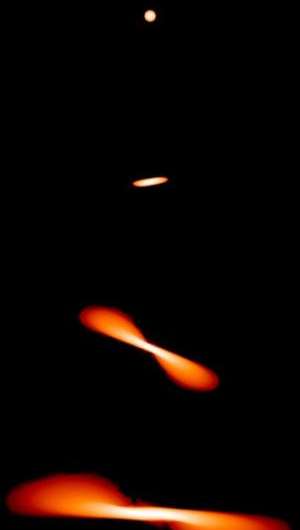Black hole chokes on a swallowed star

A five-year analysis of an event captured by a tiny telescope at McDonald Observatory and followed up by telescopes on the ground and in space has led astronomers to believe they witnessed a giant black hole tear apart a star. The work is published this month in The Astrophysical Journal.
On January 21, 2009, the ROTSE IIIb telescope at McDonald caught the flash of an extremely bright event. The telescope's wide field of view takes pictures of large swathes of sky every night, looking for newly exploding stars as part of the ROTSE Supernova Verification Project (RSVP). Software then compares successive photos to find bright "new" objects in the sky—transient events like the explosion of a star or a gamma-ray burst.
With a magnitude of -22.5, this 2009 was event was as bright as the "superluminous supernovae" (a new category of the brightest stellar explosions known) that the ROTSE team discovered at McDonald in recent years. The team nicknamed thwie 2009 event "Dougie," after a character in the cartoon South Park. (Its technical name is ROTSE3 J120847.9+430121.)
The team thought Dougie might be a supernova, and set about looking for its host galaxy (which would be much too faint for ROTSE to see). They found that the Sloan Digital Sky Survey had mapped a faint red galaxy at Dougie's location. The team followed that up with new observations of the galaxy with one of the giant Keck telescopes in Hawaii, pinpointing the galaxy's distance at three billion light-years.
These deductions meant Dougie had a home—but just what was he? Team members had four possibilities: a superluminous supernova; a merger of two neutron stars; a gamma-ray burst; or a "tidal disruption event"—a star being pulled apart as it neared its host galaxy's central black hole.
To narrow it down, they studied Dougie in various ways. They made ultraviolet observations with the orbiting Swift telescope, and took many spectra from the ground with the 9.2-meter Hobby-Eberly Telescope at McDonald. Finally, they used computer models of how the light from different possible physical processes that might explain how Dougie would behave—how it varies in brightness over time, and what chemical signatures it might show—and compared them to Dougie's actual behavior.
In detail, Dougie did not look like a supernova. The neutron star merger and gamma-ray burst possibilities were similarly eliminated.
"When we discovered this new object, it looked similar to supernovae we had known already," said lead author Jozsef Vinko of the University of Szeged in Hungary. "But when we kept monitoring its light variation, we realized that this was something nobody really saw before. Finding out that it was probably a supermassive black hole eating a star was a fascinating experience," Vinko said.
Team member J. Craig Wheeler, leader of the supernova group at The University of Texas at Austin, elaborated. "We got the idea that it might be a 'tidal disruption' event," he said, explaining that means that the enormous gravity of a black hole pulls on one side of the star harder than the other side, creating tides that rip the star apart.
"A star wanders near a black hole, the star's side nearer the black hole is pulled" on more than the star's far side, he said. "These especially large tides can be strong enough that you pull the star out into a noodle" shape.
The star "doesn't fall directly into the black hole," Wheeler said. "It might form a disk first. But the black hole is destined to swallow most of that material."
Though astronomers have seen black holes swallow stars before—though less than a dozen times—this one is special even in that rare company: It's not going down easy.
Models by team members James Guillochon of Harvard and Enrico Ramirez-Ruiz at the University of California, Santa Cruz, showed that the disrupted stellar matter was generating so much radiation that it pushed back on the infall. The black hole was choking on the rapidly infalling matter.
Based on the characteristics of the light from Dougie, and their deductions of the star's original mass, the team has determined that Dougie started out as a Sun-like star, before being ripped apart.
Their observations of the host galaxy, coupled with Dougie's behavior, led them to surmise that the galaxy's central black hole has the "rather modest" mass of about a million Suns, Wheeler said.
Delving into Dougie's behavior has unexpectedly resulted in learning more about small, distant galaxies, Wheeler said, musing "Who knew this little guy had a black hole?"
More information: "A Luminous, Fast Rising UV-Transient Discovered by ROTSE: a Tidal Disruption Event?" J. Vinko et al., 2015, Astrophysical Journal, Vol. 798, No. 1, Art. 12 dx.doi.org/10.1088/0004-637X/798/1/12 , On Arxiv: arxiv.org/abs/1410.6014
Journal information: Astrophysical Journal , arXiv
Provided by University of Texas at Austin





















